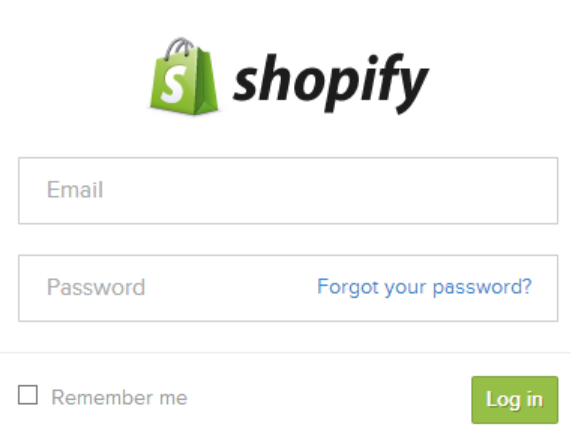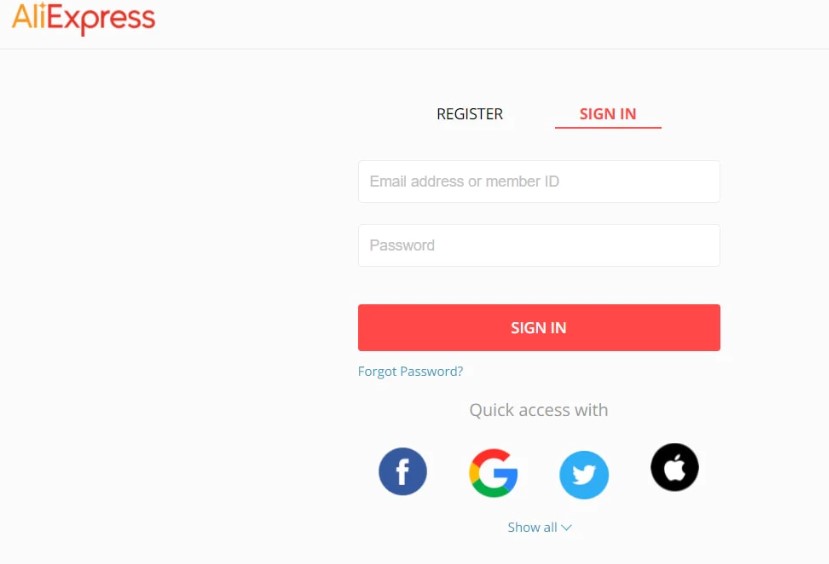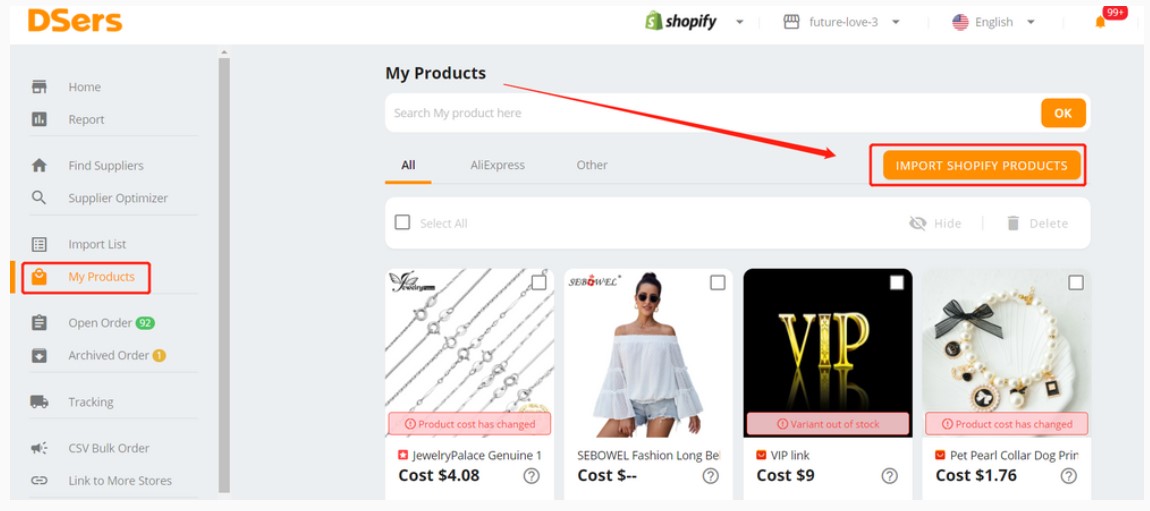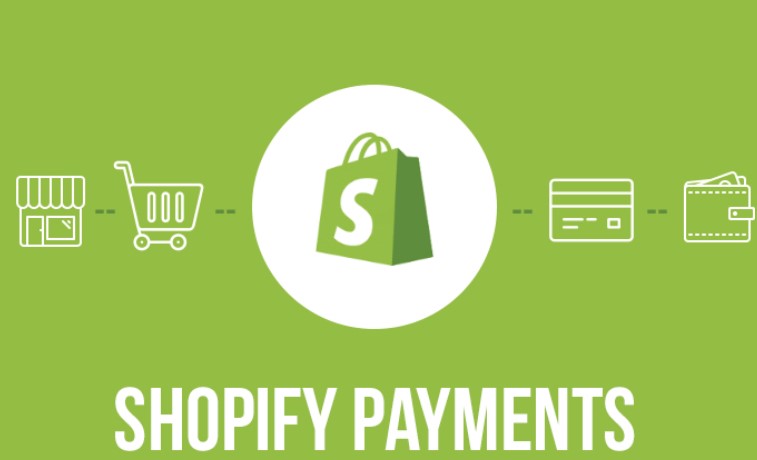Import Products from AliExpress to Shopify: A Comprehensive Guide
In this step-by-step guide, we’ll walk you through how to import products from AliExpress to Shopify, catering to both newbies and seasoned store owners.
Prerequisites for Importing Products
Importing products from AliExpress to your Shopify store involves several prerequisites and basic requirements. Here’s a list of the essential prerequisites:

- Shopify Account: You must have an active Shopify account. If you don’t have one, you can sign up for a Shopify free trial before making a purchase.

AliExpress Account: You need an AliExpress account to access and browse products on their platform. You can create an AliExpress account for free.
Payment Method: Ensure you have a valid payment method linked to your Shopify and AliExpress accounts for transaction purposes.
Store Setup: Your Shopify store should be set up with a basic theme, your branding, and necessary pages like About Us, Contact Us, Shipping and Return Policies, etc.
Product Niche and Strategy: Decide on your product niche and import strategy. It is crucial to know what types of products you want to sell and how you plan to market them.
Product Research: Before importing products, conduct thorough research on AliExpress to find products that align with your niche, have good reviews, and are from reliable suppliers.
Legal Requirements: Ensure you comply with all legal requirements related to your business, including tax registration, business permits, and compliance with import/export regulations in your country.
</b>Shipping and Fulfillment Strategy</b>: Have a clear shipping and order fulfillment strategy. Decide whether you’ll use ePacket shipping, standard shipping, or other methods. Also, set shipping rates and times on your Shopify store.
Pricing Strategy: Determine your pricing strategy, including how you’ll set product prices to cover your costs, make a profit, and remain competitive.
Customer Service Setup: Establish a customer service plan, including how you’ll handle customer inquiries, returns, and refunds. Ensure you have the necessary communication channels in place.
Marketing Plan: Develop a marketing plan to promote your products and drive traffic to your Shopify store. Consider using social media marketing, email marketing, SEO, and other tactics.
Inventory Management: Implement an inventory management system to keep track of product availability and avoid overselling.
Legal Documents: Create and display essential legal documents on your website, such as a Privacy Policy, Terms of Service, and Refund Policy.
Secure Your Store: Ensure your Shopify store is secure with SSL certification to protect customer data.
Once you have these prerequisites in place, you can start importing products from AliExpress to your Shopify store using the chosen app or another method.
Step-by-Step Guide to Import Products by DSers
If you own an online store or are into dropshipping, it’s important to keep adding new products to your Shopify store to help your business grow. You can make this process easier and faster with helpful tips and tools.
Import by AliExpress product URL
Dsers is a highly advanced tool for eCommerce stores that use dropshipping. One of its standout features is the Supplier Optimizer, which automatically searches the internet to find top-notch dropshipping suppliers. It then seamlessly imports their entire range of products into your store.

To import products from DSers to your Shopify store, you can easily follow these steps:
- Step 1: Login to DSers and click “Import List.”
- Step 2: To push a single product, hover over its Product Card and click the “Push” button. Select the products to bulk import by checking the boxes on the Product Card and then click the “Push to Shopify” button.
- Step 3: A pop-up will appear, allowing you to choose the destination in your Shopify store where you want to send the products.
- Step 4: To complete the process, click the “Push to Shopify” button.
Import by DSers Chrome extension
Before you start, ensure that you have installed the DSers Chrome extension in your Chrome browser.
- Step 1: Login to AliExpress
- Step 2: Click “Add to DSers” on the product details page or click DS on the product card on the product category page
- Step 3: Login to DSers and Import List to check your imported products.
Benefits of using DSers for adding products to Shopify:
There are several advantages to using DSers for adding products to your Shopify store:
- Time-saving: Save you a lot of time by automating the process of adding products to your Shopify store.
- Increased Accuracy: Enhance the accuracy and consistency of your product information.
- Improved Efficiency: Streamline your workflow, making overall operations more efficient.
- Enhanced Functionality: Provides additional features that might not be found in Shopify’s native product creation tool.
Payment and Pricing Strategies
Payment
After importing products from Aliexpress to Shopify, you can set up different payment gateway options. As follows:
- Shopify Payments

Shopify Payments is Shopify’s own payment gateway, removing the need for third-party setups. It seamlessly integrates with major payment providers. After a customer pays, it can take up to three days for merchants to receive the funds. Card fees depend on the Shopify plan: The basic plan charges 2.9% + 30¢, the standard plan is at 2.9% + 30¢, and the Shopify offers 2.6% + 30¢, all without hidden fees.
- PayPal

PayPal is a favored option for Shopify dropshippers due to its ease of setup and both free and premium account choices. It handles international payments, supports mobile use, and integrates directly with merchant accounts.
Shopify automatically sets up a PayPal Express Checkout account for merchants. However, with transaction fees of 1.9% to 3.4%, using Shopify Payments to bypass these charges might be beneficial..
- Amazon Pay

Amazon Pay integrates smoothly with Shopify, offering a swift and reliable payment method. However, it requires an Amazon Professional Seller account at $39.99/month.
While it’s efficient, its transaction fees can be higher, potentially challenging for smaller businesses needing quick cash flow. Additionally, payments might take days to process.
Pricing Strategies
Enabling multiple currencies in Shopify Payments allows customers to see product prices in their local currency. This feature helps set fixed prices and bypass changes from currency fluctuations.
If multiple products need updating, you can easily import a CSV file or use the Shopify API for adjustments.
Set fixed product prices for a market
To set fixed prices for specific markets, visit your Shopify admin’s Markets page. Here, you can determine unique product prices for each active market, bypassing any auto-converted international rates. For fixed sale prices in global markets, import them via a CSV file, since this can’t be done directly in Shopify’s admin.
For instance, if your main market is the U.S. with USD as the base, and you have Canada with CAD and a combined market of Australia and New Zealand with AUD, here’s how to set fixed prices:
- For products priced at 5 CAD in the Canadian market, input 5.00 in the market price field.
- For products priced at 6 AUD in the Australian market, input 6.00 in the market price field.
Shipping and Fulfillment
Shipping
Managing shipping and fulfillment is key for a Shopify store that sells AliExpress items. When you integrate AliExpress with Shopify, you have various fulfillment options. If you opt for dropshipping, the supplier takes responsibility for packaging and sending products directly to your customers.
On the other hand, some sellers choose to warehouse and dispatch products themselves, giving them more control but demanding more resources. It’s crucial for you to set clear shipping expectations and offer tracking information to your customers.
Synchronize AliExpress Orders with Shopify Fulfillment
To ensure a smooth order fulfillment process for AliExpress products on your Shopify store, synchronization is crucial. Here are the steps to sync AliExpress orders with your Shopify store:
- Step 1: When a customer places an order on your Shopify store, double-check that all details, including shipping address and product variant, are accurate.
- Step 2: Log in to your AliExpress account and place the order with the respective supplier, ensuring the shipping address matches the customer’s details.
- Step 3: Update the order status on your Shopify store to indicate that the order has been placed and is in the supplier’s processing queue.
- Step 4: Once the supplier ships the product, input the provided tracking information into your Shopify store.
- Step 5: Notify the customer about the shipment and provide them with the tracking details for monitoring delivery progress.
- Step 6: Continuously monitor the order fulfillment process to ensure orders are processed and shipped promptly.
By synchronizing AliExpress orders with your Shopify store’s fulfillment system, you create a seamless shopping experience for your customers, covering order placement to product delivery.
Handling Customer Service
Handling customer service is paramount when importing products from AliExpress to Shopify. Here’s a breakdown of essential areas to consider:
1. Returns
Origin of Returns: Since you’re sourcing from AliExpress, the products will often come from international suppliers. This can complicate the return process, as sending overseas items can be costly and time-consuming.
Return Policies: It’s vital to have a clear return policy. Given the challenges with international returns, some sellers choose to refund the customer without requiring them to send the product back, or they opt for a partial refund to cover potential return costs.
Handling Damaged Goods: If a customer receives a damaged product, decide whether you’ll require photographic evidence before processing a refund or replacement.
2. Refunds
Processing Time: AliExpress can have longer delivery times due to international shipping. You may face refund requests if a product doesn’t arrive within the expected timeframe. It’s essential to clarify with customers the potential for delays and set expectations upfront.
Partial vs. Full Refunds: Decide under which circumstances you’ll offer partial or full refunds. For instance, you might provide a partial refund if a product is slightly different but still functional.
Restocking Fees: Some sellers implement a restocking fee to cover administrative costs. However, be transparent about this in your policies to avoid customer dissatisfaction.
3. Customer Inquiries
Response Time: Fast responses build trust. Aim to reply to customer queries within 24 hours. Given time zone differences with suppliers on AliExpress, ensure you factor this into your response time.
Template Responses: Consider the common questions or issues that might arise (e.g., shipping delays or product inquiries), and prepare template responses. This can speed up your response time and ensure consistency.
Transparent Communication: Always be honest with your customers. If there’s a delay or issue, let them know upfront. Building trust through transparency can lead to repeat business and positive reviews.
Why AliExpress?
AliExpress, an online retail platform under the Alibaba Group, caters to both businesses and individual shoppers.
Acting as a middleman connecting sellers and buyers, it provides a wide array of products at competitive prices, often featuring items that might not be readily available through local suppliers. Moreover, AliExpress encompasses diverse product categories, including electronics, fashion, home and garden, toys, and beauty products.
In brief, when you’re looking to find products for your Shopify store, AliExpress is a great choice for several reasons. Let’s break down the main advantages of using AliExpress for adding products to your online store:
- Affordable Prices:
AliExpress is popular for its affordable prices, making it ideal for startups on a budget and established stores wanting to boost profits. With its vast product range, businesses can offer competitive prices and still earn a good profit.
- Diverse Product Selection:
AliExpress has a vast selection from numerous suppliers, enabling exploration of different niches and meeting diverse customer needs. Whether you’re into electronics, fashion, or home decor, you’ll find plenty of options to consider.
- Easy Integration with Shopify:
One of AliExpress’s significant advantages is its seamless integration with Shopify. This integration simplifies adding products to your online store, saving you time and effort. Here’s how it works:
- Step 1: Once you’ve picked the products you want to sell on AliExpress, you can use apps like DSers to import them directly into your Shopify store.
- Step 2: These apps let you customize product details such as titles, descriptions, and pricing to fit your brand and target audience.
- Step 3: Any changes in product availability or pricing on AliExpress can be automatically synced with your Shopify store, ensuring that your product listings are always up to date.
-
Step 4: Many apps provide order fulfillment features, making it easy to place orders with AliExpress suppliers without hassle.
- Trustworthy Supplier Ratings:
AliExpress has a supplier rating and feedback system. This lets you assess a supplier’s reliability and product quality before partnering. High ratings and positive reviews typically signal trustworthy suppliers with quality products and good service.
- Accessibility to International Customers:
AliExpress offers global access to Chinese suppliers, making it easier for businesses and consumers alike. This promotes cross-border trade and allows SMEs to tap into the international market.
FAQs
- Install and set up the DSers app on your Shopify store.
- Use DSers to find and import products from AliExpress to your store.
- Customize product details like titles, descriptions, and pricing to align with your brand and target audience.
- Manage orders and fulfill them directly through DSers with AliExpress suppliers.
Final Thoughts
Importing products from AliExpress to Shopify offers vast opportunities for eCommerce enthusiasts, whether you’re new or experienced. This guide provides the insights and tools to grow your product range and boost your business.





